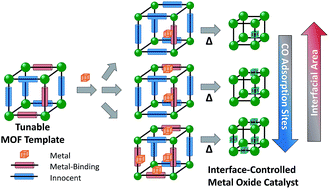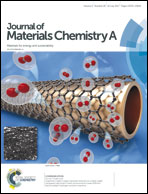Controlling interfacial properties in supported metal oxide catalysts through metal–organic framework templating†
Abstract
Precise control over the chemical structure of hard-matter materials is a grand challenge of basic science and a prerequisite for the development of advanced catalyst systems. In this work we report the application of a sacrificial metal–organic framework (MOF) template for the synthesis of a porous supported metal oxide catalyst, demonstrating proof-of-concept for a highly generalizable approach to the preparation of new catalyst materials. Application of 2,2′-bipyridine-5,5′-dicarboxylic acid as the organic strut in the Ce MOF precursor results in chelation of Cu2+ and affords isolation of the metal oxide precursor. Following pyrolysis of the template, homogeneously dispersed CuO nanoparticles are formed in the resulting porous CeO2 support. By partially substituting non-chelating 1,1′-biphenyl-4,4′-dicarboxylic acid, the Cu2+ loading and dispersion can be finely tuned, allowing precise control over the CuO/CeO2 interface in the final catalyst system. Characterization by X-ray diffraction, X-ray absorption fine structure spectroscopy, and in situ IR spectroscopy/mass spectrometry confirm control over interface formation to be a function of template composition, constituting the first report of a MOF template being used to control interfacial properties in a supported metal oxide. Using CO oxidation as a model reaction, the system with the greatest number of interfaces possessed the lowest activation energy and better activity under differential conditions, but required higher temperature for catalytic onset and displayed inferior efficiency at 100 °C than systems with higher Cu-loading. This finding is attributable to greater CO adsorption in the more heavily-loaded systems, and indicates catalyst performance for these supported oxide systems to be a function of at least two parameters: size of adsorption site and extent of interface. Optimization of catalyst materials thus requires precise control over synthesis parameters, such as is demonstrated by this MOF-templating method.



 Please wait while we load your content...
Please wait while we load your content...